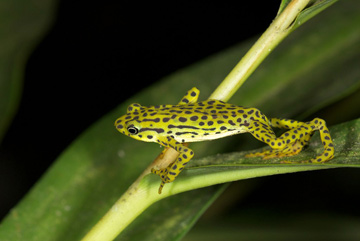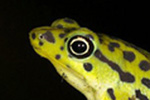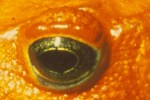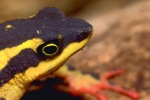Unprecedented search evidence of ‘Sixth Great Extinction’.
Last August, a group of conservation agencies launched the Search for Lost Frogs, which employed 126 researchers to scour 21 countries for 100 amphibian species, some of which have not been seen for decades. After five months, expeditions found 4 amphibians out of the 100 targets, highlighting the likelihood that most of the remaining species are in fact extinct; however the global expedition also uncovered some happy surprises. Amphibians have been devastated over the last few decades; highly sensitive to environmental impacts, species have been hard hit by deforestation, habitat loss, pollution, agricultural chemicals, overexploitation for food, climate change, and a devastating fungal disease, chytridiomycosis. Researchers say that in the past 30 years, its likely 120 amphibians have been lost forever.
The Search for Lost Frogs conducted by Conservation International (CI), the IUCN Amphibian Specialist Group (ASG), and Global Wildlife Conservation (GWC), hoped to find species whose status remained unknown. The unprecedented search did uncover surviving populations of the Cave Splayfoot Salamander (Chiropterotriton mosaueri) of Mexico (not seen since 1941), the Mount Nimba Reed Frog (Hyperolius nimbae) of Ivory Coast (last seen in 1967), and the Omaniundu Reed Frog (Hyperolius sankuruensis) of Democratic Republic of Congo (not seen since 1979). In addition the search announced today that it also rediscovered the Rio Pescado stubfoot toad of Ecuador (to read more about this discovery: Researchers rediscover one of the world’s most sought-after lost frogs). This find was especially gratifying as the toad was the only rediscovered amphibian on the Search’s Top Ten List (ranked number six). After being tipped off by a local community, the researchers found a single adult toad.
 Raorchestes chalazodes)was last seen in 1874! Rediscovered after 136 years. This striking fluorescent green frog with ash-blue thighs and black pupils with golden patches (highly unusual traits among amphibians) frog leads a secretive life, presumably inside reeds during the day. It is thought that the species does not have a free-swimming tadpole stage, but completes development inside the egg. Rediscovered by Ganesan R, Seshadri KS and SD Biju. Listed by the IUCN as Critically Endangered. Photo: © SD Biju.” > Raorchestes chalazodes)was last seen in 1874! Rediscovered after 136 years. This striking fluorescent green frog with ash-blue thighs and black pupils with golden patches (highly unusual traits among amphibians) frog leads a secretive life, presumably inside reeds during the day. It is thought that the species does not have a free-swimming tadpole stage, but completes development inside the egg. Rediscovered by Ganesan R, Seshadri KS and SD Biju. Listed by the IUCN as Critically Endangered. Photo: © SD Biju.” >The Chalazodes Bubble-nest Frog (Raorchestes chalazodes)was last seen in 1874! Rediscovered after 136 years. This striking fluorescent green frog with ash-blue thighs and black pupils with golden patches (highly unusual traits among amphibians) frog leads a secretive life, presumably inside reeds during the day. It is thought that the species does not have a free-swimming tadpole stage, but completes development inside the egg. Rediscovered by Ganesan R, Seshadri KS and SD Biju. Listed by the IUCN as Critically Endangered. Photo: © SD Biju. Related articles Researchers rediscover one of the world’s most sought-after lost frogs (02/17/2011) The Search for Lost Frogs, a global expedition to uncover amphibian species not seen for decades, has uncovered one of the expedition’s most sought-after species: the Pescado stubfoot toad (Atelopus balios). The discovery in Ecuador was one bright spot in a search that revealed more about the crisis and extinctions of frogs than it did about the hopefulness of finding cryptic communities. In total the expedition rediscovered 4 of its 100 targeted species. Photos: ‘Lost amphibian’ search makes good: three ‘extinct’ species rediscovered (09/22/2010) A search for 100 of the world’s ‘lost amphibians’—unseen for decades and in many cases supposed extinct—have turned up three species so far, one of which hasn’t been recorded since the Nazis were bombing London. The lost amphibian expeditions, formed by Conservation International (CI) and the IUCN Amphibian Specialist Group (ASG), have found surviving populations of the cave splayfoot salamander (Chiropterotriton Mosaueri) in Mexico, the Mount Nimba reed frog (Hyperolius Nimbae) in the Ivory Coast, and the Omaniundu reed frog (Hyperolius sankuruensis) from the Democratic Republic of Congo. Photos: world’s top ten ‘lost frogs’ Scientists hunt for ‘lost frogs’ around the globe you're currently offline |



 (08/09/2010) The International Union for the Conservation of Nature (IUCN) and Conservation International (CI) have sent teams of researchers to 14 countries on five continents to search for the world’s lost frogs. These are amphibian species that have not been seen for years—in some cases even up to a century—but may still survive in the wild. Amphibians worldwide are currently undergoing an extinction crisis. While amphibians struggle to survive against habitat loss, climate change, pollution, and overexploitation, they are also being wiped out by a fungal disease known as chytridiomycosis.
(08/09/2010) The International Union for the Conservation of Nature (IUCN) and Conservation International (CI) have sent teams of researchers to 14 countries on five continents to search for the world’s lost frogs. These are amphibian species that have not been seen for years—in some cases even up to a century—but may still survive in the wild. Amphibians worldwide are currently undergoing an extinction crisis. While amphibians struggle to survive against habitat loss, climate change, pollution, and overexploitation, they are also being wiped out by a fungal disease known as chytridiomycosis.  (08/09/2010) From now through October, teams of scientists will be scouring through leaf litters, in shallow pools, under rocks, and in tree trunks for the world’s ‘lost frogs’. Searching in 14 countries on five continents, the researchers are looking for some 100 species of frogs that have not been seen in decades and in some cases up to a century. While some of the species may well be extinct, researchers are holding out hope that they can find the ones that are still hanging on, albeit by a thread.
(08/09/2010) From now through October, teams of scientists will be scouring through leaf litters, in shallow pools, under rocks, and in tree trunks for the world’s ‘lost frogs’. Searching in 14 countries on five continents, the researchers are looking for some 100 species of frogs that have not been seen in decades and in some cases up to a century. While some of the species may well be extinct, researchers are holding out hope that they can find the ones that are still hanging on, albeit by a thread. 










